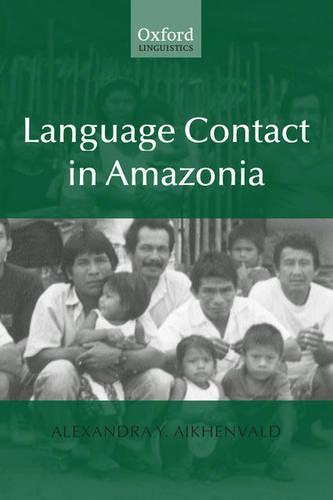Overview
This book considers how forms and meanings of different languages at different times may resemble one another and what the explanation is for this. The author aims (a) to explain and identify the relationship between areal diffusion and the genetic development of languages, and (b) to discover the means of distinguishing what may cause one language to share the characteristics of another. This is done using the example of Arawak and Tucanoan languages spoken in the large area of the Vaupés river basin in northwest Amazonia, which spans Colombia and Brazil. In this region language is seen as a badge of identity: language mixing, interaction, and influence are resisted for ideological reasons. Professor Aikhenvald considers which grammatical categories are most and which are least likely to be borrowed in a situation of prolonged language contact where lexical borrowing is reduced to a minimum. She provides a genetic analysis of the languages of the region and considers their historical relationships with languages of the same family outside it. She also examines changes brought about by recent contact with European languages and culture, and the linguistic and cultural effects of being part of a group that is aware its language and identity are threatened. The book is presented in relatively nontechnical language and will interest linguists and anthropologists.
Full Product Details
Author: Alexandra Aikhenvald (Professor and Research Leader, Cairns Institute, James Cook University)
Publisher: Oxford University Press
Imprint: Oxford University Press
Dimensions:
Width: 16.30cm
, Height: 2.70cm
, Length: 24.10cm
Weight: 0.720kg
ISBN: 9780199257850
ISBN 10: 019925785
Pages: 398
Publication Date: 16 January 2003
Audience:
College/higher education
,
Postgraduate, Research & Scholarly
Format: Hardback
Publisher's Status: Active
Availability: To order

Stock availability from the supplier is unknown. We will order it for you and ship this item to you once it is received by us.
Reviews
...one of the essential resources in language-contact literature. Edward J Vajda, Western Washington University Language Contact in Amazonia has the indisputable merit of conveying and analysing the phenomena surrounding language contact in a concrete and straightforward way ... Many existing preconceptions will be challenged by the highly unusual and compelling character of these Tariana data, which may be unique of their kind. There can be no doubt that Aikhenvald's book will have a lasting influence on future theoretical developments related to language contact. Journal of Linguistics What makes this book an outstanding source for understanding of contact-induced language change is, first, that it constitutes one of the most comprehensive studies that are available on the impact of language contact on a particular group of languages, and, second, that it describes in detail the magnitude of areal diffusion and its implications for grammatical categorization. Journal of Social Linguistics It is hard to find any deficiencies in this volume ... the text is coherent and intelligible. The findings presented are remarkable. Journal of Social Linguistics Language Contact in Amazonia is must reading for students of Amazonian languages, language change, convergence, areal linguistics, lexical and grammatical borrowing, and many other areas in the sociology of language. SIL Electronic Book Reviews
...one of the essential resources in language-contact literature. Edward J Vajda, Western Washington University Language Contact in Amazonia has the indisputable merit of conveying and analysing the phenomena surrounding language contact in a concrete and straightforward way ... Many existing preconceptions will be challenged by the highly unusual and compelling character of these Tariana data, which may be unique of their kind. There can be no doubt that Aikhenvald's book will have a lasting influence on future theoretical developments related to language contact. Journal of Linguistics What makes this book an outstanding source for understanding of contact-induced language change is, first, that it constitutes one of the most comprehensive studies that are available on the impact of language contact on a particular group of languages, and, second, that it describes in detail the magnitude of areal diffusion and its implications for grammatical categorization. Journal of Social Linguistics It is hard to find any deficiencies in this volume ... the text is coherent and intelligible. The findings presented are remarkable. Journal of Social Linguistics Language Contact in Amazonia is must reading for students of Amazonian languages, language change, convergence, areal linguistics, lexical and grammatical borrowing, and many other areas in the sociology of language. SIL Electronic Book Reviews
`What makes this book an outstanding source for understanding of contact-induced language change is, first, that it constitutes one of the most comprehensive studies that are available on the impact of language contact on a particular group of languages, and, second, that it describes in detail the magnitude of areal diffusion and its implications for grammatical categorization. It is by now widely accepted that in situations of intense language contact virtually any linguistic phenomena can be transferred from one language to another; what the author reveals in this book is first how contact can affect almost the entire structure of grammatical categorization and, second, that rather than leading to simplification, grammatical transfer has the effect that the grammar of the languages involved becomes more complex. It is hoped that this book will serve as a model for future work on language contact in other parts of the world.' Journal of Social Linguistics
Author Information
Alexandra Aikhenvald is Professor of Linguistics and Deputy Director of the Research Centre for Linguistic Typology at La Trobe University. She was a Research Fellow at the Institute of Oriental Studies of the Academy of Sciences of the USSR 1980-89, and Professor of Linguistics at the Federal University of Santa Catarina, Brazil, until 1994.




